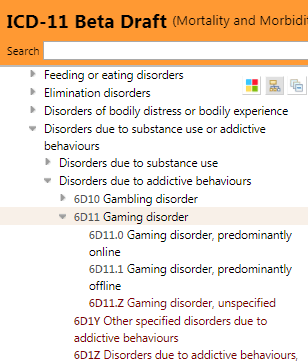
Is computer gambling too much a mental health disorder? Doctors have been discussing this problem for a long time,
many scientific works have been published. But now, it seems, scientists have come to some consensus. In 2018, the World Health Organization (WHO)
planned to add game dependency to the official
International Classification of Diseases ICD-11 (ICD-11) , along with other types of diseases that world science has discovered over the past 28 years - so much time has passed since the adoption of the tenth revision classifier (ICD-10) in 1989.
In the new version of ICD, game addiction is assigned the classifier of the disease
6D11 , online game addiction - 6D11.0, offline game addiction - 6D11.1, and undefined game addiction - 6D11.Z. So if you see these codes in your medical record, you will now know what they mean. Obviously, for an accurate diagnosis, the therapist must find out which game the patient is playing in — the code for the online, offline, or undefined form of the disorder depends on it.
According to the definition from the new handbook of diseases, gaming disorder is characterized by a pattern of constant or repetitive game behavior that can occur on the Internet or offline. The disorder manifests itself as follows:
- Weakened control over the game process (start, frequency, intensity, duration, termination, context).
- Increased priority of games compared to other vital interests and daily activities.
- Continuation or escalation of game activity despite the occurrence of negative consequences.
If the behavioral pattern is sufficiently serious, then the disorder can significantly affect a person’s personal, family and social life, his educational or professional activities, as well as other important areas of activity, the description says.
Game dependence can be observed as a continuous obsessive behavior, or occur sporadically with a constant return to the games. Diagnosis usually requires the patient to show abnormal behavior during the past 12 months. In other words, if a gamer “went into the string” and did not return to computer games for a year, then this can be considered an example of successful rehabilitation if he does not return to his old habit again.
The period of symptoms for the diagnosis may be less than 12 months, it is said in the instructions, "if the diagnostic requirements are met, and the symptoms appear in severe form."
In the classification of diseases, dependence on computer games (6D11) took place alongside similar mental disorders - dependence on gambling (6D10), other uncertain disorders due to addictions (6D1Y).
The classifier states that painful attachment to 6D11 games should be distinguished from the problem of the dangerous QF02 game. This is a problem when a person spends too much time playing games that threaten his mental or physical health or the health of those around him. Judging by the description, the problem of QF02 may precede the formation of the painful attachment of 6D11, that is, at this stage, mental dependence has not yet been fully formed.
So far, ICD-11 has the status of a draft. Perhaps, as a result of the stormy indignation of the gaming community, this “mental disorder” will still be removed from the classifier. Still, cybersport is now recognized as an official sport, and considering the dependence on computer games to be a form of frustration is formally the same thing as considering excessive interest in chess, football, or swimming to be a disease.
The forums have already begun to discuss the consequences of the official recognition of gambling addiction a form of mental illness. They are discussing what medicines the doctors will prescribe in this case - and whether they will give a sick-list with exemption from school and work. Perhaps especially avid gamers will begin to be treated in stationary dispensaries and correctional camps, as in China. Until 2009, players were treated
there, including with the use of shock therapy (electrical wires were attached to the temples and arms of a teenager, which were allowed to discharge from 1 to 5 milliamperes), and now they use psychotropic drugs and complete isolation of patients with the outside world.